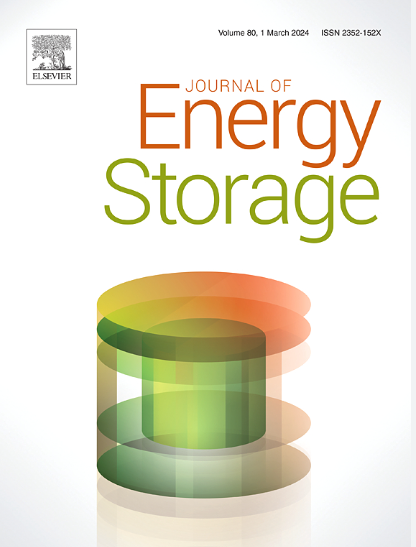扩散控制的插层和表面氧化还原电荷存储行为的电化学阻抗谱(EIS)特性的物理解释
IF 8.9
2区 工程技术
Q1 ENERGY & FUELS
引用次数: 0
摘要
交流阻抗响应是表征金属离子电池(包括钠离子电池和锂离子电池)电化学性能的重要标准。这项工作研究了锂离子电池中扩散控制插层和钠离子电池中表面氧化还原电荷存储的电化学阻抗谱(EIS)。为此,对浸入锂离子或钠离子电解质中的 TiO2 纳米粒子进行了基于第一原理的物理建模。奈奎斯特图显示了锂离子存储的典型电荷转移电阻、扩散阻抗和电容行为。钠离子储存则没有扩散阻抗。同样,离子浓度响应的径向分布显示,锂离子存储有明显的斜率跃变,钠离子存储也没有。此外,在数值和实验中,锂离子存储和钠离子存储的电荷转移电阻都是先保持不变,然后随着偏置电位的增加而增加。这与 CV 曲线中的法拉第和电容状态相对应。此外,弛豫时间分布(DRT)分析显示了两个不同的峰值,分别对应于电荷转移过程和扩散过程。最后,随着电极纳米粒子直径的增加,锂离子存储的电阻也增加了,这是因为扩散途径增加了。另一方面,钠离子插层与电极纳米粒子的大小无关。这项研究为通过 EIS 分析区分外在假电容和内在假电容提供了启示。本文章由计算机程序翻译,如有差异,请以英文原文为准。
Physical interpretation of the electrochemical impedance spectroscopy (EIS) characteristics for diffusion-controlled intercalation and surface-redox charge storage behaviors
AC impedance response is an important criteria in characterizing the electrochemical performance of metal ion batteries, including sodium ion batteries (SIBs) and lithium ion batteries (LIBs). This work investigates the electrochemical impedance spectroscopy (EIS) of diffusion-controlled intercalation in LIBs and surface-redox charge storage in SIBs. To do so, a first-principle based physical modeling was performed for a nanoparticle of TiO immersed in lithium ion or sodium ion electrolytes. Nyquist plots showed typical charge transfer resistance, diffusion impedance, and capacitive behaviors for lithium ion storage. The diffusion impedance was absent for sodium ion storage. Similarly, the radial distribution of ion concentration response showed significant slope jump for lithium ion storage, also absent for sodium ion storage. In addition, the charge transfer resistance first remained constant then increased with the increase in bias potential for both lithium ion storage and sodium ion storage, both numerically and experimentally. This corresponded to the Faradaic and capacitive regimes in the CV curves. Furthermore, distribution of relaxation time (DRT) analysis showed two distinct peaks, corresponding to the charge transfer process and the diffusion process. Finally, the resistances of lithium ion storage increased with the increase in electrode nanoparticle diameter, due to the increase in diffusion pathways. On the other hand, sodium ion intercalation was independent of the size of the electrode nanoparticle. This investigation offered insights in distinguishing extrinsic pseudocapacitance from intrinsic pseudocapacitance through EIS analysis.
求助全文
通过发布文献求助,成功后即可免费获取论文全文。
去求助
来源期刊

Journal of energy storage
Energy-Renewable Energy, Sustainability and the Environment
CiteScore
11.80
自引率
24.50%
发文量
2262
审稿时长
69 days
期刊介绍:
Journal of energy storage focusses on all aspects of energy storage, in particular systems integration, electric grid integration, modelling and analysis, novel energy storage technologies, sizing and management strategies, business models for operation of storage systems and energy storage developments worldwide.
 求助内容:
求助内容: 应助结果提醒方式:
应助结果提醒方式:


